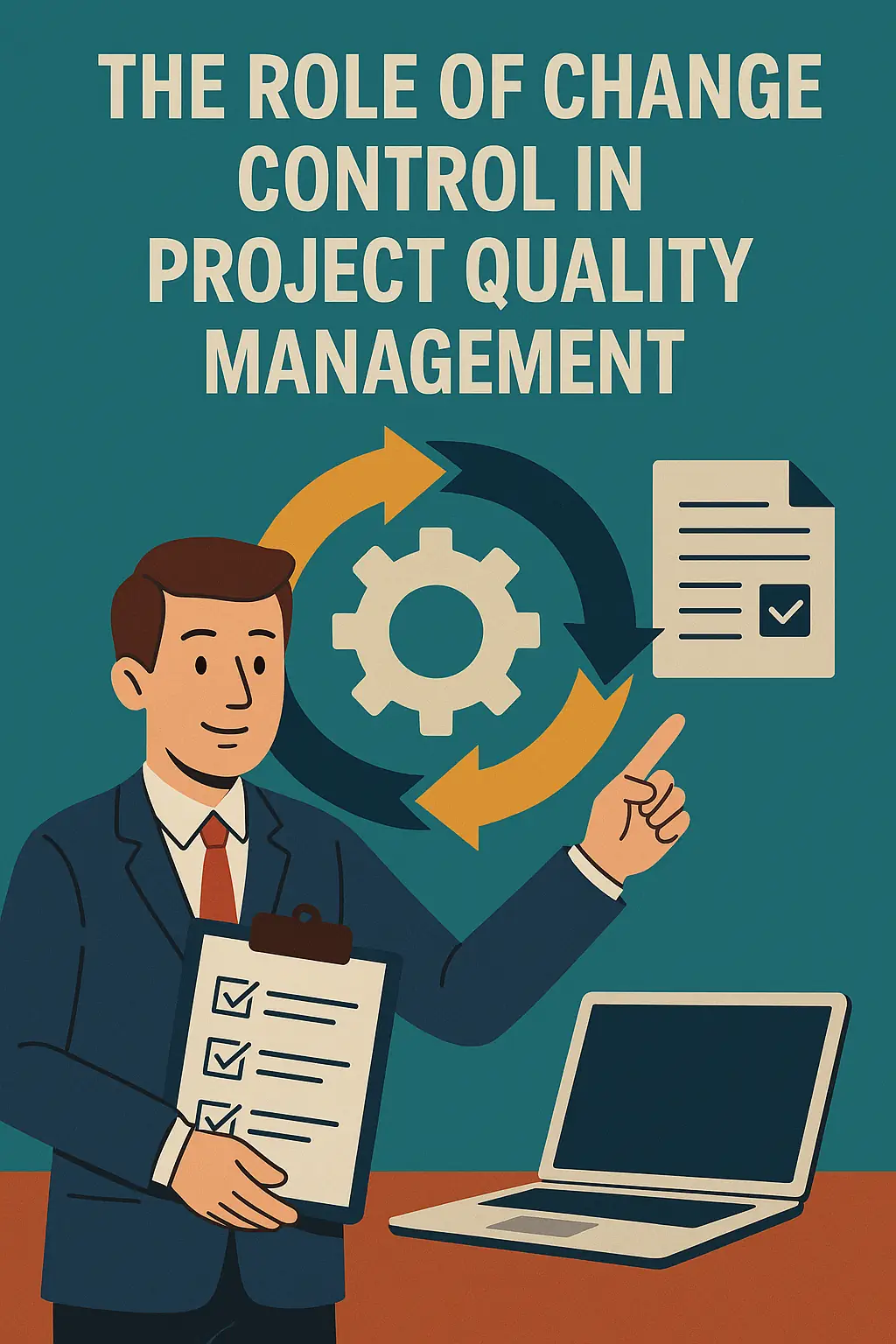Introduction to Change Control in Project Management
Change control is a critical component of project management that ensures any modifications to the project scope, schedule, or resources are systematically managed and documented. This process is essential for maintaining project quality and achieving desired outcomes. Below are key points that outline the significance of change control in project management.
Definition of Change Control
Change control refers to the process of requesting, evaluating, and implementing changes to a project. It involves a structured approach to managing alterations, ensuring that all changes are assessed for their impact on project objectives, timelines, and resources. The primary purpose of change control is to minimize disruption and maintain project integrity by ensuring that all stakeholders are informed and involved in the decision-making process.
Importance of Managing Changes to Ensure Project Quality
Managing changes effectively is vital for several reasons:
- Quality Assurance: Changes, if not controlled, can lead to scope creep, which may compromise the quality of deliverables. By implementing a change control process, project managers can evaluate the potential impact of changes on quality and make informed decisions that align with project goals.
- Risk Mitigation: Change control helps identify risks associated with proposed changes. By assessing these risks, project teams can develop strategies to mitigate them, ensuring that quality is not sacrificed in the face of new requirements or adjustments.
- Stakeholder Engagement: A well-defined change control process fosters communication among stakeholders. It ensures that everyone involved understands the implications of changes, which can lead to better collaboration and a shared commitment to maintaining quality standards.
Overview of Change Control Integration within the Project Management Lifecycle
Change control is not a standalone process; it is integrated throughout the project management lifecycle. Here’s how it fits into various phases:
- Initiation: During the project initiation phase, change control processes are established to define how changes will be managed. This includes setting up a change control board (CCB) and outlining procedures for submitting change requests.
- Planning: In the planning phase, project managers develop a change management plan that details how changes will be assessed, approved, and implemented. This plan is crucial for ensuring that quality considerations are embedded in the project from the outset.
- Execution: As the project progresses, change requests may arise. The change control process allows project teams to evaluate these requests against project objectives and quality standards, ensuring that any approved changes are implemented without compromising quality.
- Monitoring and Controlling: Throughout the project, monitoring mechanisms are in place to track changes and their impacts on quality. Regular reviews and audits help ensure that the change control process is followed and that quality remains a priority.
- Closure: At project closure, a final review of all changes is conducted to assess their impact on project quality. Lessons learned from the change control process can inform future projects, enhancing overall quality management practices.
Understanding the Change Control Process Flow
The change control process is crucial for maintaining project integrity and ensuring that any modifications contribute positively to the overall quality outcomes. This section outlines the structured flow of the change control process, emphasizing its significance in achieving project quality objectives.
1. Identification of Changes
The first step in the change control process is recognizing the need for change. This can arise from various sources, including:
- Stakeholder Feedback: Input from team members, clients, or other stakeholders can highlight areas needing improvement.
- Performance Metrics: Monitoring project performance against established metrics may reveal discrepancies that necessitate changes.
- Risk Management: Identifying new risks or changes in existing risks can prompt a reevaluation of project plans.
Recognizing these triggers early is essential for timely intervention and maintaining project quality.
2. Documentation of Change Requests
Once a change is identified, thorough documentation is critical. This step involves:
- Creating a Change Request: A formal document that outlines the proposed change, including its rationale, scope, and potential benefits.
- Detailing the Impact: Clearly articulating how the change will affect project deliverables, timelines, and resources.
- Tracking Changes: Utilizing a change log to maintain a record of all requests, approvals, and implementations ensures transparency and accountability.
Proper documentation not only facilitates communication among stakeholders but also serves as a reference for future projects.
3. Impact Analysis
Evaluating the potential effects of proposed changes is a vital step in the change control process. This analysis should include:
- Quality Assessment: Determining how the change will impact the quality of the project deliverables.
- Cost-Benefit Analysis: Weighing the costs associated with implementing the change against the expected benefits.
- Risk Evaluation: Identifying any new risks introduced by the change and assessing their potential impact on project quality.
Conducting a thorough impact analysis helps ensure that changes align with quality objectives and do not compromise project integrity.
4. Approval Process
The approval process is essential for ensuring that all changes are vetted and agreed upon by relevant stakeholders. This typically involves:
- Review by Change Control Board (CCB): A designated group of stakeholders reviews the change request and impact analysis.
- Decision Making: The CCB decides whether to approve, reject, or request further information regarding the change.
- Documentation of Decisions: All decisions made during this process should be documented to maintain a clear record of approvals and rationales.
This structured approach to approvals helps mitigate risks and ensures that only beneficial changes are implemented.
5. Implementation of Changes
Once a change is approved, the next step is its implementation. This phase includes:
- Planning the Implementation: Developing a detailed plan that outlines how the change will be executed, including timelines and resource allocation.
- Communicating Changes: Informing all stakeholders about the change and its implications for the project.
- Executing the Change: Carrying out the change according to the established plan while monitoring for any issues that may arise.
Effective implementation is crucial for ensuring that the change achieves its intended quality outcomes.
6. Review and Closure
The final step in the change control process is the review and closure phase, which involves:
- Post-Implementation Review: Assessing the effectiveness of the change in achieving the desired quality improvements.
- Documentation of Outcomes: Recording the results of the change, including any lessons learned and recommendations for future changes.
- Closure of Change Request: Formally closing the change request in the change log, ensuring that all documentation is complete and accessible for future reference.
This phase is vital for continuous improvement, as it allows teams to learn from each change and refine their processes for future projects.
Linking Change Control to Quality Outcomes
The change control process is a critical component that directly influences the quality of project deliverables. For Quality Assurance Managers and Project Leads, understanding the intricate relationship between change control and quality outcomes is essential for ensuring project success.
The Relationship Between Change Control and Quality Assurance
- Definition of Change Control: Change control refers to the systematic approach to managing changes in a project, ensuring that all changes are documented, assessed, and approved before implementation. This process is vital for maintaining project integrity and quality standards.
- Quality Assurance Integration: Quality assurance (QA) involves the systematic monitoring and evaluation of various aspects of a project to ensure that standards and procedures are being followed. By integrating change control with QA processes, organizations can ensure that any modifications do not compromise the quality of the project deliverables. This integration helps in:
- Identifying Quality Risks: Change control processes allow teams to assess potential risks associated with changes, enabling proactive measures to mitigate quality issues.
- Ensuring Compliance: Changes that are properly controlled and documented help maintain compliance with industry standards and regulations, which is crucial for quality assurance.
Common Pitfalls in Change Control That Can Negatively Impact Quality Outcomes
- Inadequate Documentation: One of the most common pitfalls in change control is the lack of thorough documentation. When changes are not properly recorded, it becomes challenging to track their impact on quality. This can lead to misunderstandings and misalignment among team members, ultimately affecting the project’s quality.
- Insufficient Stakeholder Involvement: Failing to involve all relevant stakeholders in the change control process can result in critical insights being overlooked. This lack of collaboration can lead to changes that do not align with quality objectives, potentially compromising the final deliverable.
- Neglecting Impact Analysis: A change control process that does not include a comprehensive impact analysis can lead to unforeseen consequences on quality. It is essential to evaluate how proposed changes will affect existing processes, resources, and quality standards to avoid negative outcomes.
- Resistance to Change: Change can often be met with resistance from team members, especially if they do not understand the rationale behind it. This resistance can hinder the effective implementation of change control processes, leading to quality issues if changes are not embraced and executed properly.
Best Practices for Effective Change Control in Quality Management
The change control process plays a pivotal role in ensuring that project outcomes meet the desired quality standards. Here are some actionable strategies for Quality Assurance Managers and Project Leads to enhance their change control processes:
1. Establishing Clear Change Control Policies and Procedures
- Define a Structured Framework: Develop comprehensive change control policies that outline the steps for submitting, reviewing, and approving changes. This framework should include criteria for evaluating the impact of changes on project quality and deliverables.
- Documentation Standards: Ensure that all change requests are documented consistently. This includes detailing the nature of the change, the rationale behind it, and its potential impact on project quality. Clear documentation helps in tracking changes and their effects over time.
2. Involving Stakeholders in the Change Control Process
- Engage Key Stakeholders: Involve relevant stakeholders, including team members, clients, and other affected parties, in the change control process. Their insights can provide valuable perspectives on the potential impacts of changes on project quality.
- Feedback Mechanisms: Implement feedback loops where stakeholders can express their concerns or suggestions regarding proposed changes. This collaborative approach not only enhances buy-in but also helps identify quality risks early in the process.
3. Utilizing Project Management Tools to Streamline Change Control
- Adopt Technology Solutions: Leverage project management software that includes change control functionalities. Tools like Jira, Trello, or Asana can help track change requests, approvals, and their implementation status, making the process more transparent and efficient.
- Automate Notifications and Updates: Use automated notifications to keep all stakeholders informed about changes and their status. This ensures that everyone is on the same page and can respond promptly to any issues that arise.
4. Regular Training and Workshops for Team Members on Change Control Practices
- Continuous Learning: Organize regular training sessions and workshops focused on change control best practices. This helps team members stay updated on the latest methodologies and tools, fostering a culture of quality awareness.
- Simulations and Role-Playing: Incorporate practical exercises, such as simulations or role-playing scenarios, to help team members understand the implications of change control on project quality. This hands-on approach can enhance their ability to manage changes effectively.
By implementing these best practices, Quality Assurance Managers and Project Leads can significantly improve their change control processes, leading to better quality outcomes in their projects. A well-structured change control process not only mitigates risks but also enhances stakeholder satisfaction and project success.
Measuring the Impact of Change Control on Project Quality
The change control process is pivotal in ensuring that any modifications to the project scope, schedule, or resources are systematically evaluated and managed. This section delves into how effective change control processes can significantly influence project quality outcomes, particularly for Quality Assurance Managers and Project Leads.
Key Performance Indicators (KPIs) for Evaluating Change Control Effectiveness
To assess the effectiveness of change control processes, it is essential to establish clear Key Performance Indicators (KPIs). These metrics provide a quantifiable means to evaluate how well changes are managed and their subsequent impact on project quality. Some critical KPIs include:
- Change Request Approval Rate: This measures the percentage of change requests that are approved versus those submitted. A high approval rate may indicate that the change control process is effectively filtering necessary changes that align with project goals.
- Time to Process Change Requests: This KPI tracks the average time taken to evaluate and approve change requests. A shorter processing time can reflect an efficient change control process, which can help maintain project momentum and quality.
- Impact on Project Deliverables: Evaluating the quality of deliverables before and after changes can provide insights into how well the change control process mitigates risks associated with modifications. This can be assessed through quality audits and stakeholder feedback.
- Defect Rates Post-Change: Monitoring the number of defects or issues arising after a change is implemented can help gauge the effectiveness of the change control process. A decrease in defects may indicate that changes are being managed effectively.
Feedback Mechanisms for Continuous Improvement
Implementing robust feedback mechanisms is crucial for the continuous improvement of change control processes. These mechanisms can include:
- Post-Implementation Reviews: Conducting reviews after changes are implemented allows teams to assess what worked well and what did not. This feedback can inform future change control processes and enhance overall project quality.
- Stakeholder Surveys: Gathering input from stakeholders regarding their perceptions of the change control process can provide valuable insights. Surveys can help identify areas for improvement and ensure that the process aligns with stakeholder expectations.
- Lessons Learned Sessions: Regularly scheduled sessions to discuss lessons learned from change implementations can foster a culture of continuous improvement. Documenting these lessons can serve as a reference for future projects.
Tools and Techniques for Monitoring and Reporting Changes and Their Impacts on Quality
Utilizing the right tools and techniques is essential for effectively monitoring and reporting changes and their impacts on project quality. Some recommended tools include:
- Change Management Software: Tools like Jira, Trello, or Asana can help track change requests, approvals, and implementation status. These platforms often include features for reporting and analytics, making it easier to visualize the impact of changes on project quality.
- Quality Management Systems (QMS): Integrating change control processes with a QMS can enhance the ability to monitor quality outcomes. These systems can provide real-time data on quality metrics and facilitate compliance with industry standards.
- Dashboards and Reporting Tools: Utilizing dashboards that aggregate data from various sources can provide a comprehensive view of how changes affect project quality. These tools can help project leads make informed decisions based on real-time data.
- Root Cause Analysis Tools: Techniques such as the Fishbone Diagram or the 5 Whys can be employed to analyze defects or quality issues arising from changes. Understanding the root causes can help refine the change control process and improve quality outcomes.
Conclusion
The structured change control process plays a pivotal role in ensuring the quality of project outcomes. By systematically managing changes, organizations can mitigate risks, enhance stakeholder communication, and maintain alignment with project objectives. Here are the key takeaways regarding the importance of change control in project quality management:
- Critical Role in Quality Management: Change control serves as a safeguard for project quality by providing a framework for evaluating the impact of proposed changes. This process ensures that any alterations are thoroughly assessed for their potential effects on project deliverables, timelines, and resources. By doing so, it helps prevent scope creep and ensures that the project remains on track to meet its quality standards.
- Prioritization by Quality Assurance Managers and Project Leads: It is essential for Quality Assurance Managers and Project Leads to prioritize the change control process within their projects. By embedding change control into the project lifecycle, these leaders can foster a culture of quality and accountability. This proactive approach not only enhances the overall project quality but also builds trust among stakeholders, as they can be assured that changes are managed effectively.
Find out more about Shaun Stoltz https://www.shaunstoltz.com/about/.
This post was written by an AI and reviewed/edited by a human.



